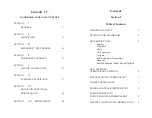
Arsi AB – Esqual
www.arsi.se
FLIGHT & OPERATION MANUAL ESQUAL VM-1
Page 41of 54
6.1 INTRODUCTION
Emergencies caused by airframe or engine malfunctions may be significantly reduced or
eliminated with proper pre-flights. Emergencies can be minimized or eliminated by careful
flight planning and good judgment when unexpected weather is encountered.
However, should an emergency arise the basic guidelines should be considered and applied as
necessary to correct the problem.
6.2 GENERAL RECOMMANDATIONS FOR EMERGENCY
PREVENTION
a) Hangar or cover your aircraft and maintain engine, airframe and pilot logs.
b) Drain old fuel and replace with fresh fuel. Spoiled auto fuel will varnish your cylinders and
cause rings to stick. The hotter the weather, the faster fuel will deteriorate. Drain and clean
float bowls as well, being sure they are replaced correctly.
c) Run engine regularly, if possible. For long periods of down time, store engine in accordance
with manufacturers recommendations.
d) Follow your maintenance schedule and replace all parts within specified periods or when
they show signs of wear.
e) Keep current. If you don’t fly for any extended period get a checkout and some tips from a
professional instructor. You’ll be surprised how much you will learn.
f) Use a landing strip that matches your skill level and judgment. Avoid one way and uphill
strips if possible.
g) Remember to always start your take off run at the very start of the runway. If full RPM are
not achieved, abort take off. Treat every take off with respect, realizing that the sooner you
get to altitude, the safer you are. Get off fast and climb at best rate turning crosswind as soon
as you consider you couldn’t make a safe emergency landing straight ahead. Keep your
downwind close and within gliding distance. If at your own private strip circle it to gain
altitude while monitoring engine temp and RPM.
REMEMBER ALTITUDE AND AIRSPEED ARE YOUR BEST FRIENDS
6.3 AIRSPEED FOR EMERGENCY OPERATION
Engine failure after take off
115 km/h flaps DOWN / 140 km/h flaps UP
Maximum glide
140 km/h flaps UP
Precautionary landing with engine power
95 km/h
Landing without engine power
110 km/h - FINAL
Landing without flaps
110 km/h - FINAL
6.4 ENGINE FAILURES
1. Engine failures during take off
a) Throttle: Idle
b) Brakes:
Apply
c) Magnets: Off
d) Master:
Off
e) Remove from runway and inspect
Содержание VM-1C
Страница 8: ...Arsi AB Esqual www arsi se FLIGHT OPERATION MANUAL ESQUAL VM 1 Page 8 of 54 1 1 CHARACTERISTICS ...
Страница 25: ...Arsi AB Esqual www arsi se FLIGHT OPERATION MANUAL ESQUAL VM 1 Page 25of 54 Flap chain ...
Страница 29: ...Arsi AB Esqual www arsi se FLIGHT OPERATION MANUAL ESQUAL VM 1 Page 29of 54 ...
Страница 32: ...Arsi AB Esqual www arsi se FLIGHT OPERATION MANUAL ESQUAL VM 1 Page 32of 54 5 2 PRE FLIGHT INSPECTION ...












































